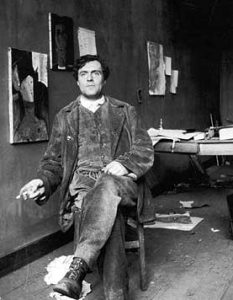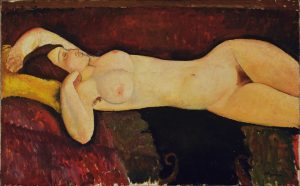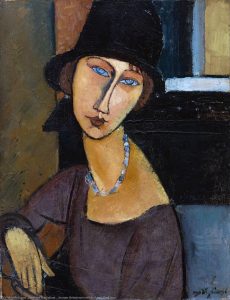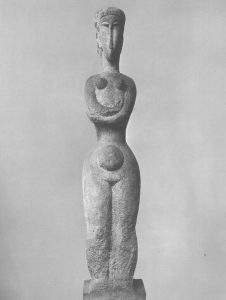Amedeo Clemente Modigliani was an Italian Jewish painter and sculptor known for his portraits and nudes characterized by the elongation of faces, necks, and figures.

Image source: https://search.creativecommons.org/photos/cc5e3589-d194-474e-abfd-e378f7af21d8 by Cea.
A central participant at the Ecole de Paris, Modigliani modernized the portrait and the nude. His portraits are characterized by a sense of melancholy, elongated proportions, and mask-like faces inspired by sources such as Constantin Brancusi and African art, they are also both specific and highly stylized, each uniquely revealing life interior of the subject.
Early life

Image source: https://commons.wikimedia.org/wiki/File:Amedeo_Modigliani_Photo.jpg
Amedeo, or “Dedo,” Modigliani was the youngest of four children of Jewish parents, Flaminio and Eugenia, in Livorno, Italy, home to a large Jewish community. Shortly before his birth, the family businesses had fallen out of favor, forcing the Modigliani’s to declare bankruptcy. The arrival of Amedeo led to the rescue of many precious relics; according to family legend, the soldiers were forced to avoid Eugenia during childbirth as they came to retrieve the furniture, according to an ancient Italian custom that prohibited the seizure of anything in the bed of a woman in childbirth.
Modigliani’s nudes

Image source: https://search.creativecommons.org/photos/d3c3ec85-c7c4-4039-931c-e9713387b93b by Tulip Hysteria / Go to albums
Modigliani has upset the tradition of the nude. His works in this genre were modern in their candid sensuality, and lacking in modesty and mythological subtext. Because of these qualities – along with the artist’s notorious womanizing – Modigliani’s nudes were scandalously received the moment they were created. Modigliani’s nudes scandalized audiences with their depiction of features such as pubic hair and their blunt, unadorned sexuality.
Portraits

Image source: https://commons.wikimedia.org/wiki/File:Amedeo-Modigliani-Jeanne-Hebuterne-with-Hat-and-Necklace.jpg
Modigliani’s portraiture achieves a unique combination of specificity and generalization. His portraits convey the personalities of his subjects, while his distinctive stylization and use of recurring motifs – long necks and almond-shaped eyes – give them uniformity. Modigliani’s portraiture is a vital historical-artistic document, which includes a gallery of important figures from the Ecole de Paris circle, to which he belonged after his move to Paris in 1906.
Sculpture

Image source: https://search.creativecommons.org/photos/98be7ba4-ca2a-4006-a8bf-44576d91272b by bianca.maggio
Perhaps the single most important experience on Modigliani’s creative development was the work of the Romanian sculptor Constantin Brancusi. Although Modigliani is best known as a painter, he has also devoted himself to sculpture since the beginning of his career and, some writers have argued that was his true calling. The sculptures that Modigliani created in 1909-14, of which twenty-five carvings and a woodcut survive, had a great influence on his work as a painter, helping him to develop the abstract and linear vocabulary of his painting.
Info sources: https://www.britannica.com/biography/Amedeo-Modigliani https://www.theartstory.org/artist/modigliani-amedeo/ https://en.wikipedia.org/wiki/Amedeo_Modigliani https://www.museothyssen.org/en/collection/artists/modigliani-amedeo
